Fabric Building Structures Foundation Options

Concrete Footing
This foundation works well for almost
all fabric building applications.
It allows for secure anchoring in many
types of soil and provides a fastening
area for a clean finish of the fabric.
The cost of this type of foundation is
largely dependant on the dimensions of
the concrete and the amount of
reinforcing steel.
They are easy to construct and pour and
require no specialized equipment making
it relatively simple to find a
contractor who is able and willing to do
the installation.
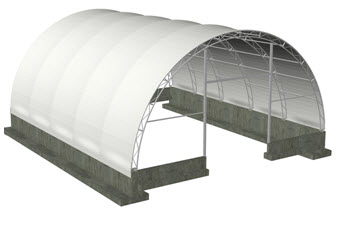
Concrete Wall Foundation
This foundation is very similar to the
concrete footing and is constructed in a
similar fashion as most residential home
foundations.
This design allows the owner to add more
height to the building maximizing the
usable interior space, and allowing for
greater clearance.
This type of foundation is commonly
found in industrial settings where
equipment and materials have a tendency
of running into and damaging ground
mounted buildings.
The height of the wall can be adjusted,
and sometimes pilasters will need to be
added for support.
This type of foundation is excellent for
commodity storage as it keeps things
from piling up against the fabric. The
cost of this type of foundation is
usually higher than most other options,
but in certain applications the added
functionality outweighs the additional
cost.
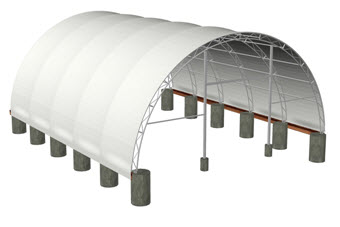
Concrete Pier Foundation
The concrete pier foundation can be a
very good solution depending on the
composition of the soil.
It is strongly recommended that a soils
report be done before committing to this
type of foundation because rocky soil or
low compaction could send the cost
skyrocketing.
In most cases this can be a very
economical solution because the concrete
requirement will be lower and it
requires significantly less labor.
The downside to this type of foundation
is that the fabric does not finish as
neat as it does on other foundations,
and the reliability is questionable
without a soils report.
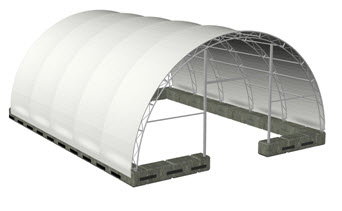
Concrete Block Foundation
Concrete blocks are an excellent
solution for smaller fabric buildings.
Like a concrete wall this type of
foundation allows the building to be
raised up off the ground to meet
clearance requirements, and to provide
additional interior space.
It also allows for the
foundation to be moved at a later date.
The downside to this foundation is that
if you want to mount a larger building
it will require a significant number of
blocks strapped together in order to
withstand the loads.
If you plan to use this type of
foundation all of the blocks will need
to come from a manufacturer that can
supply engineering information.
This is one of the most portable
foundations, but it is difficult to
finish in a manner that is aesthetically
pleasing.
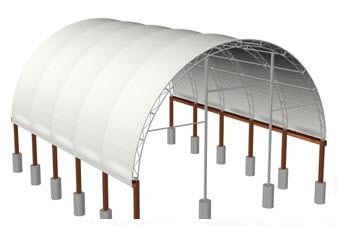
Post Foundation
A post foundation uses either wooden or
steel risers in order to raise the
building above ground level.
Due to the strength of this type of
system it is usually only feasible for
use on smaller buildings, and can
only be used up to a certain height.
This type of foundation is quite often
found in agricultural and equine related
usages because it allows for more usable
space, and is a very economical.
It also allows for the addition of
wooden or corrugated steel paneling
which can increase the security and the
aesthetic appeal of the building.
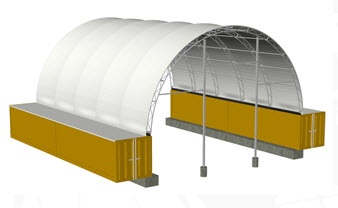
Conex Box Foundation
Conex box foundations are most often
found in the industrial setting and have
many attributes that make them
appealing. Much like posts and concrete
walls this foundation will raise the
building up off the ground providing
added interior space and extra
clearance.
It also allows for the use of the Conex
box as additional storage and work
space.
The supplier of the Conex box will need
to be able to supply engineering and
specifications on the box in order to
utilize this type of foundation.
It also usually requires additional
bracing at the anchor points in order to
be secure.
The cost on this type of foundation is
usually quite low depending on the
supplier.
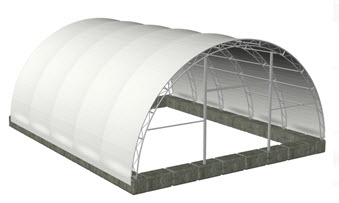
Buried Ecology Block Foundation
This foundation allows for pre-cast
concrete blocks to be used to secure a
large fabric building.
By burying the ecology block you provide
additional support, and subsequently
decrease the number of blocks required.
This can often be a very simple and
economic way to secure your building.
Foundation Considerations
Soils Reports-
It is recommended by Milestones Building & Design that a
geotechnical firm be consulted prior to every project to
determine the site conditions in your area.
Once a soils report is done the foundation engineer will
have definite figures for soil compaction, settlement,
and composition.
This will allow him to design your foundation based on
your site instead of the assumed worst case scenario.
In most cases a soils report will save you more money on
your foundations than you spent for the consultation.
Depending on your location sometimes this will be a
requirement.
Foundation Engineering-
A good foundation is the key to a great building
installation. Engineered foundation drawings will be
required for both permitting and construction.
During this step the foundation engineer will take into
account the foundation type, soil compaction and
composition, and the loads exerted by the building.
Using this information he will design a foundation that
will stand up to the expected loading.
End Wall Considerations-
During the design of your foundation it is important to
keep in mind how the end wall steel and fabric will
finish. In the
event that you are designing a foundation that will lift
the building off of the ground you will need to
designate whether the foundation will come up to support
the end wall steel or if you would like to drop the
steel to ground level.
The fabric should also be considered as the apron drop
will need to be changed to accommodate differing
foundation designs.
Foundation
Now is the time to decide who will handle
the different aspects of the foundation installation for
your project.
Please consider your options carefully and determine
what will be the best option for you.
Should you need further assistance regarding your fabric covered
buildings foundation, please email us.
|








